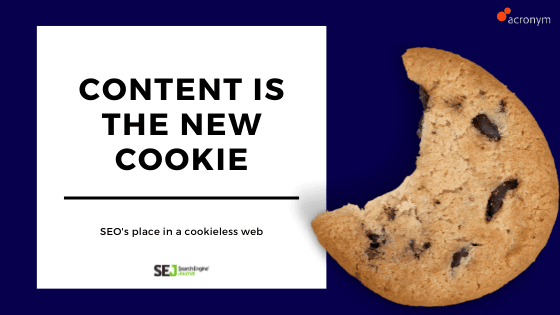Acronym’s SVP, SEO, Winston Burton recently shared his thoughts on SEO in a cookieless world with Search Engine Journal. Here is a reprint of that article.
Losing cookies may impact SEO. Here’s how content as the new cookie might help brands better understand user needs in a cookieless world.
The move away from cookie-based tracking is a response to increasing public concern around privacy.
This scrutiny comes on the heels of data breaches and scandals that have plagued Facebook, Google, Amazon, Apple, and other Silicon Valley behemoths in recent years.
There’s been much discussion of how search marketers and PPC professionals can prepare for a cookieless web.
But an important question remains: How will the shift from cookies impact SEO? In this post, we’ll explore this change through the lenses of:
- Personalization in the SERPs.
- The importance of first-party data.
- The role of Google Search Console.
- Information vs. transactional content.
- Measurement.
Let’s start with what a cookie is and why brands are using them in the first place.
What Is a Cookie?
A cookie is a small text file saved on your device when you visit a website. It stores information about your preferences and other data.
From a consumer perspective, cookies help websites operate more efficiently. They do things like remember passwords and save the items we put into our shopping carts.
On the brand side, they help us understand how visitors use different parts of a website so we can improve the experience for future visitors.
But cookies also help advertisers follow consumers around the web – sometimes far longer and wider than those consumers realize.
These are the “bad” cookies that have resulted in public concern.
The aim of the EU’s General Data Protection Regulation (GDPR), the California Consumer Privacy Act (CCPA), and similar laws is to give consumers visibility into how cookies are being used on websites – especially those that could be classified as “bad.”
This legislation is also designed to give consumers more control over how brands are using their data to create a more seamless user experience, sell to third parties, or for their own marketing/remarketing purposes.
Why Do Companies Use Cookies?
In addition to preserving items in your shopping basket, cookies can do helpful things like preserve your login details for future visits, offer personalized discount codes (like in cart abandonment emails!) or surface recommended content.
“Articles you may be interested in…” and “Products you might like…” are all generated by cookies, for example.
In a bit of logic that is truly baffling, cookies are also used to record what types of cookies (if any) a user has opted to allow to be set in their browser.
Whether cookies are good or bad truly depends on how each brand uses them.
When a site drops a cookie, it follows you around the web and shows content from sites you have visited in the past.
For example, if I am looking for shoes and go to Zappos and do not buy anything, they drop a cookie so I get ads from Zappos as I browse further.
This could result in a helpful reminder to return to buy a pair I liked – or it could be an annoying interruption.
The Importance of First-Party Data
One big change in the cookieless future is that with less third-party data powering targeting, brands will have to instead tap into first-party data — that they collect through their websites, apps, or other services.
(Third-party data, on the other hand, is collected by an outside provider for advertising purposes.)
Unfortunately for businesses, there are many challenges to gathering quality first-party data — accuracy, privacy concerns, and costs among them.
Solutions that provide for real-time personalization can help capture and activate more relevant information about specific customers through their site usage.
And of course, once you know who they are, you can create the content they need based on their intent and your first-party data.
Informational v. Transactional Content
Another change we’ll see in this cookieless world is even more emphasis on engaging content that captures users’ interest at every stage.
The good news is this is a permission-based way of getting consumers interested in your products and services.
Marketing is all about creating relationships. The most beautiful and meaningful way to create a relationship is through relevant content that is helpful, useful, engaging, and informative.
Once you understand consumer intent, you have the data and clues you need to attract the right audience through content.
Focusing on the intent of search keywords can result in better click-through rates, conversions, etc. because you are giving people what they want when they want it, and satisfying their informational need.
For example, let’s say I wrote a gated white paper, The Ultimate Guide to Creating an SEO Audit. About 100 people fill out the form to download it.
But then our new business team gets on the phone and discovers only two were genuine leads. What was the problem here?
The issue is this article was mainly about teaching SEO professionals how to perform an audit, which is informational content, or content that educates or entertains.
It was not transactional content, which instead shows how a brand’s products and services can help readers while also reinforcing what the brand is selling and its benefits. Examples of transactional content can include white papers, as well as:
- Case studies.
- Partner success stories.
- Promoted events.
- Product demonstrations.
- Product brochures.
If I instead wrote an article like Why Brands Should Invest in an SEO Audit to Improve their ROI by 50%, it may get less traffic but generate higher quality leads because the intent is transactional. It appeals to brands or business professionals who are looking for SEO services.
Once they read the white paper, they might say, “This is exactly what I need to do. But I need help, so I’m going to contact this company to find more about their audit services.”
This is just one example of why we need to define intent before creating content.
Bonus: Structured Data
Once you get intent right and start ranking for some of your content, it’s time to apply structured data.
Having structured data can help your site show up in rich results and drive more clicks and impressions while also improving your sales and revenue.
Measurement
Measurement in a cookieless world is going to be extremely important, too.
We need to track offline purchases, map those purchases to an online experience, and show the value (i.e., what role organic search had in the purchase).
That means tracking users who consumed content and then looking for them at the conversion point to figure out if they went to an online store after reading your content.
Work with your analytics team to ensure you are tracking, measuring, and attributing content appropriately to maximize conversions.
There is an increase in brands deploying analytics and other tools on the server-side.
Server-side analytics are generally a more reliable way to measure web engagement and performance. Harder… much harder… but more reliable and more secure, too.
At the same time, users should be made aware of how they are being tracked.
Tech companies are also rolling out tools to help brands navigate the cookieless future and protect consumer privacy.
Microsoft, for example, has announced Parakeet for privacy controls. Meanwhile, Bing API has private search functionality, which is built on keeping consumer data private and addressing many of the concerns advertisers have around data.
This list also includes Google Chrome’s Privacy Sandbox and Apple IDFA.
Wrapping Up
As search engines move away from third-party cookies, it will be harder to follow a customer across digital experiences to get a full picture of their needs, behaviors, and intent.
But I think content is the new cookie, and measurement will help brands better understand what users are looking for.
In turn, brands will be able to use content and measurement to connect the dots across all stages of the fragmented user journey and provide a better user and content experience, while maximizing ROI.
Remember: Cookies were always flawed. We have been in a multi-device/omnichannel world for a while now and measurement solutions have not fully caught up for most brands.
But this is not the end of the online marketing industry.
Cookies are only the end of the marketing industry operating mysteriously behind the scenes. Brands that continue to prioritize the consumer will continue to thrive.
This is Winston’s closing bio: Winston Burton is an SEO and digital marketing expert with over 16 years of experience optimizing some of the world’s largest brands. Winston is currently the SVP, SEO at Acronym. Previously Winston was the VP,SEO at Havas Media and built the SEO practice. His experience includes enterprise brands including Marc Jacobs, Fidelity, SAP, Scotts, Dish to name a few.










